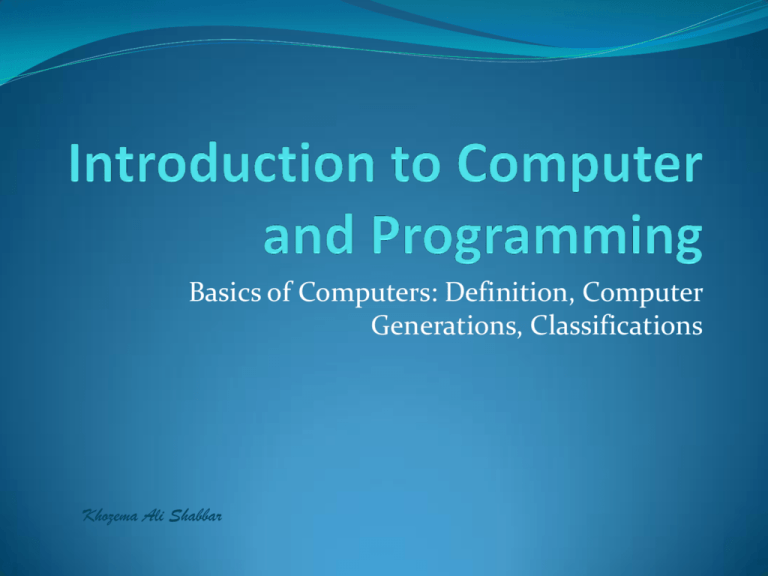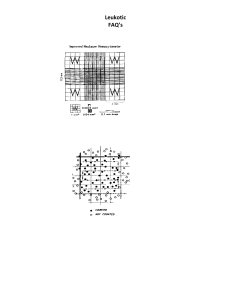
Basics of Computers: Definition, Computer
Generations, Classifications
Khozema Ali Shabbar
What is a computer ?
Monitor
System Unit
Keyboard
Floppy Disk
Drive
CD-ROM /
DVD-ROM Drive
Mouse
A computer is an electronic device that receives input, stores
and automatically manipulates data, and provides output in a
useful format(Information)
Functions-Accept, Store, Process, Retrieve and Display
Generations
Of
Computers
Generation
Years
Characteristic
1st
1944-59
Use Valves
(Vacuum tubes)ENIAC
2nd
1959-64
Use transistors
EDVAC,UNIVAC
3rd
1964-75
Large Scale
Integrated
Circuits- ALTAIR
4th
1975-
Very Large
Scale Integrated
Circuits- APPLE
5th
Under
development
“Artificial
Intelligence”
based
computers-
I- Ancient Counting Machines
1- The Abacus (base 5)
(in ancient Babylon,
China, Europe)
II- Mechanical Counting Machines
1642
2- The Pascaline is a mechanical calculating device
invented by the French mathematician Blaise Pascal
in 1642. (+)
II- Mechanical Counting Machines
1673
3- The Leibniz Wheel was invented by the famous
mathematician Leibniz in 1673.
(+,-,*,/)
II- Mechanical Counting Machines
1810
4- Punched Cards were used by the French weaver
Joseph Jacquard in 1810. The cards carried weaving
instructions for the looms, later this idea offered a
great use for storing info.
II- Mechanical Counting Machines
5- Charles Babbage’s
first computer Difference Engines to
produce tables of
numbers.
1832
This device had mechanical problems similar to
those that plagued Pascal and Leibniz.
Charles Babbage
nd
2
Computer
1858
Analytical engine
general-purpose
used binary system
punched cards as input
branch on result of previous
instruction
Ada Lovelace (first
programmer)
machined parts not
accurate enough
never quite completed
The Invention of the Vacuum Tube
6- Initially discovered by
Thomas Edison, the vacuum
tube formed the building
block for the entire
electronics industry.
*Vacuum tubes were later
used as electron valves in the
20th century to build the first
electronic computers.
1883
III- Electrical Counting Machines
In US - Herman
Hollerith invented a
calculating machine
that used electricity
along with punched
cards instead of mechanical gears.
1888
III- Electrical Counting Machines
• Hollerith’s machine was immensely successful. The
general count of the population, then 63 million,
took only 6 weeks to calculate!
• Based on the success of his invention, Herman
Hollerith and some friends formed a company that
sold his invention all over the world. The company
eventually became known as:
International Business Machines
IBM
1888
III- Electrical Counting Machines
1943
51 feet long and weighed over 5 tons
11- MARK I was built by a team from IBM and
Harvard University. Mark I used mechanical
telephone switches to store information. It accepted
data on punched cards, processed it and then output
the new data.
IV- Electronic Counting Machines
1946
12- The ENIAC was the first US-built all-electronic
computer built to perform ballistics
calculations. (Away from IBM)
IV- Electronic Counting Machines
EDVAC
(Electronic Discrete Variable Automatic Computer)
1951
UNIVAC (Universal Automatic Calculator)
Two Inventions that changed
the way computers are built!!
1- The Transistor
The most significant single invention of
the modern era. It was invented by
3 scsientists at At&T’s Bell Labs.
* Transistors are smaller (sometimes microscopic)
* Fast and don’t need to warm up
1946
Transistors on a circuit board
Resistors
Transistors
Capacitor
Two Inventions that changed
the way computers are built!!
2- The (IC) Integrated Circuit
1961
The IC revolutionized the
entire electronic technology.
Ex: The Pentium Processor
contains 3.1 Million Transistors
in 1.5 inch square!
1975 - 1981
The Altair
The Apple I
The Floppy
Disk
The Hard
Disk
MS-DOS
What Is a Computer?
Computer
Performs computations and makes logical decisions
Millions / billions times faster than human beings
Computer programs
Sets of instructions by which a computer processes data
Hardware
Physical devices of computer system
Software
Programs that run on computers
20
2003 Prentice Hall, Inc. All rights reserved.
(modified by Evan Korth)
Computer Organization
Six logical units of computer system
Input unit
Mouse, keyboard
Output unit
Printer, monitor, audio speakers
Memory unit
Retains input and processed information
Arithmetic and logic unit (ALU)
Performs calculations
Central processing unit (CPU)
Supervises operation of other devices
Secondary storage unit
Hard drives, floppy drives
21
2003 Prentice Hall, Inc. All rights reserved.
Block Diagram of Computer
Storage
CPU
COMPUTER APPLICATIONS
Robotics & Industrial Automation
Office Automation
Telecommunications
Electronic Financial Transactions
Personal Computers
Microprocessors
E-Mail & Teleconferencing
Artificial Intelligence (AI)
Internet
Merits and Demerits of Computer
Merits: Speed
Accuracy Reliability Storage capability Versatility-
Diligence-
very high speed.
Speed is measured in MIPS and BIPS.
The results are very correct.
It gives correct and consistent result always
Stores large amounts of data
Can do different types of jobs
It won’t get tired
De-Merits: Non-Intelligent-
Inactive-
It performs the given instructions only.
It does not think on its own.
It does not possess any intelligence for
analyzing the problem on its own
If no power supply, it won’t work.
Classifications of Computer
Digital computer:-Computers that works on digital data such as 0’s and 1’s
E.g. (Personal Digital Computer Assistant)
Analog computer:-They accept data whose values keep changing with respect to
time. Data may be in the form of continuous voltages, frequencies,
temperature etc.
Processing is done on continuously varying signals.
E.g. Speedometer
Hybrid Computer:-It is designed to handle digital and analog data and hence
also called analog-digital computer.
Classifications of Computers
1. Supercomputers
2. Mainframe computers
3. Minicomputers (or mid-range computers)
4. Microcomputers
Microcomputer Types
Desktop
Netbooks
Media center system
Tablet PC
units
Notebook or laptop
Handheld
Mini Computers
A mini computer is between the range of a mainframe
and a microcomputer.
Uses: Industries, Factories
10 SQ Feet area
10 Terminal
connected to CPU
Eg: Prime 997
MainFrame Computers
Largest computers on the basis of size approximately
1000 sq. feet area and the most expensive system
100 Terminals+CPU
Govenments
Eg:IBM1401
Super Computers
These computers are the fastest, most expensive the
extremely powerful
Complex mathematical calculations
Wheather Forecasting
Nuclear Research
Eg: Param
Machine Languages, Assembly Languages,
and High-level Languages
Three types of programming languages
Machine languages
Strings of numbers giving machine specific instructions
Example:
100001001011011010101010101010110
Assembly languages
English-like abbreviations representing elementary
computer operations (translated via assemblers)
Example:
LOAD
ADD
STORE
BASEPAY
OVERPAY
GROSSPAY
32
2000 Prentice Hall, Inc. All rights reserved.
Machine Languages, Assembly Languages,
and High-level Languages
High-level languages
Instructions closer to everyday English
English is a natural language. Although high level
programming languages are closer to natural languages, it is
difficult to get too close due to the ambiguities in natural
languages (a statement in English can mean different things to
different people – obviously that is unacceptable for computer
programming). However, this is a big research area of computer
science.
Use mathematical notations (translated via compilers)
Example:
grossPay = basePay + overTimePay
Interpreter – Executes high level language programs without
compilation.
33
2003 Prentice Hall, Inc. All rights reserved.
(modified by Evan Korth)
THANKS







